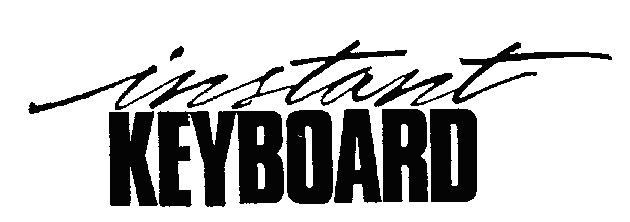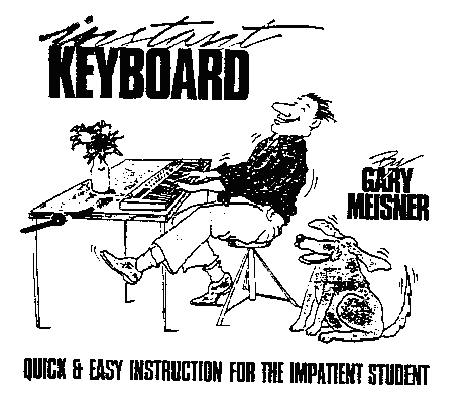*1 IN RE HAL LEONARD PUBLISHING CORPORATION, D/B/A HAL LEONARD BOOKS
Serial No. 721,617
May 14, 1990
Merchant, Gould, Smith, Edel, Welter & Schmidt, P.A. for applicant
Erin M. Falk
Trademark Examining Attorney
Law Office 1
(Deborah S. Cohn, Managing Attorney)
Before Rice, Cissel and Seeherman
Members
Opinion by Seeherman
Hal Leonard Publishing Corporation, d/b/a Hal Leonard Books, has appealed the refusal of the Examining Attorney to register INSTANT KEYBOARD (stylized), shown below, for music instruction books for self-learning on electronic keyboards. [FN1] The word KEYBOARD has been disclaimed.
Registration has been refused on two grounds: [FN1] Applicant's proposed mark, as used on its goods, so resembles the mark KEYBOARD, registered for "manuals, such as teacher's guides and student handbooks for music appreciation," [FN2] as to be likely to cause confusion, mistake or to deceive; and [FN2] the proposed mark is the title of a single creative work and identifies the work, but does not function as an indicator of the source of the goods.
We affirm on both grounds.
We turn first to the issue of likelihood of confusion. It is a well established principle of trademark law that it is not necessary that the goods of registrant and applicant be similar or competitive, or even that they move in the same channels of trade to support a holding of likelihood. It is sufficient that the respective goods are related in some manner, and/or that the conditions and activities surrounding the marketing of the goods are such that they would or could be encountered by the same persons under circumstances that could, because of the similarity of the marks, give rise to the mistaken belief that they originate from the same producer. In re International Telephone & Telegraph Corp., 197 USPQ 910 (TTAB 1978). In this case, both applicant's books and the registrant's manuals are publications which involve the subject of music. While there are specific differences in their treatment of this subject, both might be found in music stores or in the same section of a bookstore. Further, both might be purchased by the same group of customers, since the same person who wishes to learn to play on an electronic keyboard might also be interested in music appreciation. In fact, registrant's music appreciation manuals could very well include the subject of electronic keyboards or provide information that would be useful to one learning to play such an instrument. Accordingly, we conclude that the goods are sufficiently related that consumers are likely to assume a common source if they were sold under confusingly similar marks.
With respect to the marks, both consist of the word KEYBOARD, with applicant's mark containing the additional element INSTANT. Applicant argues that KEYBOARD is a suggestive and therefore weak term for items relating to music, and that INSTANT distinguishes it from the registered mark. Applicant also points to the depiction of its mark, with its different typestyles, as another distinguishing factor. We are not persuaded by these arguments. Marks must be compared in their entireties and, while in certain circumstances it is permissible to accord greater weight to one element of a mark than another in making a determination of likelihood of confusion, we do not think that the word INSTANT in applicant's mark should be accorded greater weight than the word KEYBOARD. That is, although KEYBOARD may be descriptive of an instruction book for an electronic keyboard, given its prominent depiction in applicant's mark as compared with the word INSTANT, we think that it is this word which is more likely to be noted and remembered by consumers. Further, the word INSTANT is highly suggestive of applicant's music instruction books for self-learning on electronic keyboards, in that purchasers will view it as indicating that the music instruction book will enable one to learn to play the keyboard quickly. Thus, we cannot say that INSTANT is a significant distinguishing element of applicant's mark.
*2 Finally, as the Examining Attorney has pointed out, to the extent that the issue of likelihood of confusion is in doubt, the question must be resolved in favor of the registrant. In re Whittaker Corp., 200 USPQ 54 (TTAB 1978).
This brings us to the second ground of refusal on the basis that INSTANT KEYBOARD is merely the title of a single creative work and therefore does not function as a trademark to indicate source. Over 30 years ago the Court of Customs and Patent Appeals recognized that it was then a settled principle that the title of a book cannot be registered as a trademark, and that principle remains unchanged today. See, In re Cooper, 117 USPQ 396 (CCPA 1958). Applicant, however, relies on certain language in In re Pilon, 195 USPQ 178, 179 (TTAB 1977), to wit: "a term which is the title of a book, and the only designation the book has, is not registrable as a trademark for the book." (emphasis added). Based on this language, applicant argues that INSTANT KEYBOARD is not the only designation the book has, because the cover of the book also contains the phrase "QUICK & EASY INSTRUCTION FOR THE IMPATIENT STUDENT", and that purchasers can ask for the book by this phrase or by the designation keyboard instruction book.
Applicant's argument is a misreading of In re Cooper, supra. As explained in that case, the purchaser of a book is not asking for a kind of book, such as a keyboard instruction book; he is pointing out which one out of a myriad of distinct titles he wants, designating it by name. In that sense, it does not matter whether the particular book can be categorized by type--a juvenile book in the Cooper case or a music instruction book here--or whether the type of book it is is described on the cover, e.g., by the phrase "QUICK & EASY INSTRUCTION FOR THE IMPATIENT STUDENT." The only question, when there are a variety of phrases on the cover, is which would be perceived as the title. In this case, we have no doubt that the answer is INSTANT KEYBOARD. As the following depiction of the cover shows, this phrase appears at the top of the cover, and is followed by the words BY GARY MEISNER, in obvious reference to the author.
In addition, INSTANT KEYBOARD appears on the spine of the book and on the first page without the descriptive phrase QUICK & EASY INSTRUCTION FOR THE IMPATIENT STUDENT. Moreover, in the introduction the book is referred to solely as INSTANT KEYBOARD. Thus, we find INSTANT KEYBOARD to be the title of applicant's book.
Decision: The refusal to register is affirmed on the ground of likelihood of confusion and on the ground that the proposed mark is the title of a single work.
J.E. Rice
R.F. Cissel
E.J. Seeherman
Members, Trademark Trial and Appeal Board
FN1. Application Serial No. 721,617, filed April 11, 1988 and asserting first use and first use in commerce as early as November 10, 1987.
FN2. Registration No. 1,298,783, issued October 2, 1984.



